![]()
![]()
![]()
Use LEFT and RIGHT arrow keys to navigate between flashcards;
Use UP and DOWN arrow keys to flip the card;
H to show hint;
A reads text to speech;
46 Cards in this Set
- Front
- Back
|
Features Of Metals |
-They are solid at room temperature. -Lustre shiny -Good conducters of electricity. -Malleable beaten -Ductile Wire -melt at high temperature |
|
|
Non Metals |
-Not shiny -Brittle -Not Malleable -Poor conductors electricity n heat -Melt at low temp
|
|
|
Metallic Bonding Model |
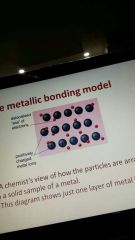
Sea of electrons Positive charged metal ions |
|
|
Why do metals have high melting points? |
Due to the strong electrostatic forced of attraction between positive metal ions and electrons. |
|
|
Metals are good conductors of electricity |
Due to the free moving delocalised electrons which move towardd a positive electrode. |
|
|
Why are metals malleable and ductile? |
BECAUSE they are held together by the delocalised electrons no natter where the protons move. |
|
|
How do we knw electrons? |
2xn^2 |
|
|
Alloys |
Formed when other materials are mixed with metals. Usually melted tohegher. Alters properties of the original metal. |
|
|
Benefits of alloys? |
Keeps good properties of the metal but remove poor properties. |
|
|
What are the 2 type of alloys? |
Substitutional Interstital |
|
|
Define Radioactivity |
Substances which are unstable and constantly giving out radiation. |
|
|
Define Isotopes |
An Isotope is an atom with a different number of neutrons. |
|
|
3 types of radiation |
Alpha Beta Gamma |
|
|
What is alpha stopped by? |
Sheet of paper. |
|
|
What is beta stopped by? |
Few mm of aluminum. |
|
|
What are gamma rays stopped by? |
Few CM of lead. |
|
|
Define Ionisation |
It turns atoms into ions by knocking of the electrons. |
|
|
Half Life |
The half life of an atom is the time taken for HALF of the radioisotopes in a sample to decay. |
|
|
Explain how and why chemical reactions occur? |
1) Particles of the reactants must collide so that they can react. 2) There must be sufficient energy in the collision. 3) The particles must be orintated correctly to allow the reacting atoms to come togetger. |
|
|
Factors affecting reaction ratw? |
Temperature Stirring/mixing Surface area of solid Cncentration Adding a catalyst |
|
|
Define Isotope |
An isotope is an atom with differeny number of neutrons. |
|
|
What are metals? |
They are cattions which have positive ions. |
|
|
What are non metals? |
Anions which have negative charge. |
|
|
Trends on the periodic table? |
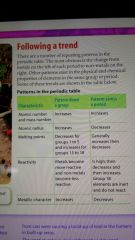
|
|
|
Properties of Ionic Compounds |
-Usually solid at room temp -hard -have high boiling point -often dissolve in water to form free mobile ions - will not conduct electricty in solid form but in molten form -are brittle |
|
|
Ionic Bonding Model |
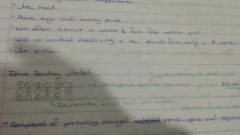
- 3D crystal lattice no beggining no end -Electrostatic Forces hold ions together. - Forces in all directions -Composed of positively charged metal ions and negatively charged nonmetal ions. |
|
|
Why are ionic compounds brittle? |
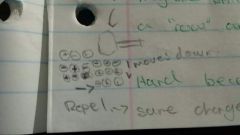
They are brittle because when hiy the atoms move down a row and repel each other causing them to shatter. |
|
|
Why does Ionic bonding not conduct electricity in solid form but in molten form? |
Because of the electrostatic forces holding the ions together, and the fact that electricty only occurs I'd there are free moving ions -- charged particles.. However if u place the lattice in water it will dissolve and will allow free movement. |
|
|
Covalent Bonding |
Between non- metals. Atoms do not gain or loose electrons they share them. |
|
|
Covalent Molecular Element |
Is made up of identical atoms. E.g c2 |
|
|
Covalen Molecular Compund |
Made up of atoms of different elements. Eg CO2 |
|
|
Lewis Diagram |
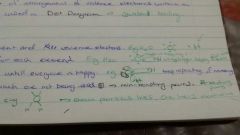
Draw each element and their valence electrons Link one atom from each element Get another element until everyone isbhappy Pair up electrons whuch are not being used Make it neat |
|
|
Atom Economy |
Atom economy js a measure of reaction efficiency. (Molar Mass of product÷ molar mass of all reactants) X 100 I.E (want/used) X 100 |
|
|
The law of conservation mass |
The atoms of an object cannot be created or destroyed, but can be moved around and be changed into different particles. |
|
|
Surface Tension |
The inward forcw or pull, tending to minimiser the surface area of liquid. |
|
|
Wetting |
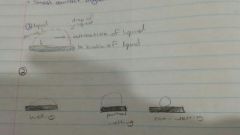
|
|
|
Define Polar Molecule |
Means that there in an uneven distribution of electron density. |
|
|
Why does oil not dissolve in water? |
Oil does not dissolve in water becasue of how molecules of each substance interact with each other. Water is a polar molecule and oil id a non polar molecule so they do not mix together. |
|
|
Structure of Fat |

|
|
|
Types of Reaction (6) |
Combination Decomposition Displacement Percipitation Neutralisaation Combustion |
|
|
What is a combination reaction? |
Two or more compounds combine to form one compound. A+B = AB |
|
|
What is a decomposition reaction? |
Opposite of combination. A complex molevule breakes down to simpler ones. AB = A+B |
|
|
What is a Percipitation reaction? |
Two solutions of soluble salts are moxed resulting in an insolube solid. Soluble salt A + Soluble salt B = Percipitate + soluble salt C |
|
|
What is a combustion reaction? |
Oxygen combines with a compound containing carbon to form carbon dioxide and water. These reaction are exothermic meaninh they give out heat. A + O2 = H20 + CO2 |
|
|
What is a displacement reaction? |
One element gates place with another element in a Compund. A + BC = AC +B |
|
|
What is neutralisation? |
An acid and bsse react with each other. Acid + base = salt + water |

